RESTAMPED License Plates
From the Metal Shortage WWII War Years
RESTAMPED License Plates
From the Metal Shortage WWII War Years
During W.W.II there was a metal shortage. The iron used in making license plates was needed to make the necessary tools of war. Scrap metal drives were a common sight in America during World War Two. Many old license plates hanging on barn walls went to the scrap heap to be recycled into jeeps, helmets, and C-Ration cans. The states themselves looked for ways to help conserve the natural resources (Gasoline, Rubber, Steel, Iron, etc.) for the WW2 War effort. One method to save metal was to only make a single license plate and not issue pairs of plates. Later, instead of issuing a new plate every year, a new metal date tab was issued to attach over the previous year's plate. The next step was to only issue a sticker to affix to the inside of the automobiles windshield. Some states even started making plates out of soybean pulp and fiberboard. These soybean plates are like press board fiber. They were made by the thousands, but goats seem to have liked the taste of them so many are found with bites taken out of them.
Several states found that they had already started making pairs of plates when the decision was made to only issue a single plate. The states saved one of the two plates and sent the other plate to the registered owner of the vehicle with that license plate number. The duplicate plates saved by the state (the mates to the ones mailed) were often: flattened and restamped with a new number or saved for another year (or more) and only the date was restamped. The restruck or overstamped plate was sent to the registered owner of that license plate in subsequent years.
Here are photographs of the plates that were first stamped, and then
restamped again in WWII to help save metal for the War effort. I do not
own all these plates. I received help in the form of photographs from several
people listed at the bottom. Please see my List
of other wanted WWII vintage license plates I am looking for. 
Please email me if you have any I collect or I am missing.
WANTED: Military
License Plates & License Plate Toppers
Bases,
Camps, Forts, Fields, Victory, etc. (but not US forces plates)
Clicking on some pictures take you to large size photographs.
World War Two - WW2 - WWII
1941, 1942, 1943, 1944, 1945
MacArthur's Four Star license plate.
Many officers fighting to hold off the invasion of the Phillipines
by the Japanese brought symbols of their rank from Manila to the new HQ
of the American Army on Corregidor. And for MacArthur it was his four star
plate which was hung over the General's desk in the tunnel on embattled
Corregidor. <source>
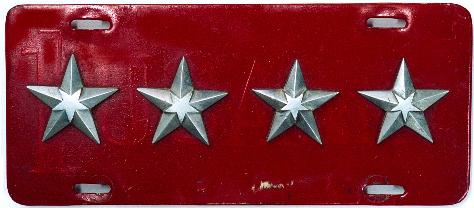
1930's - 1950's
From the 1930s to the 1950s, the Connecticut State Police Cruiser plates
were made from flattened and restamped passenger plates.
See cover of Saturday Evening Post, March 24, 1945
Can anyone send me better pictures of this type of plate to post here ?
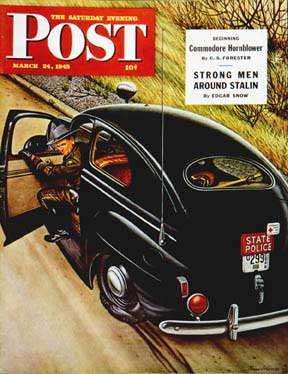 |
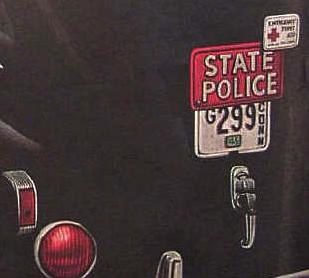
1942 Connecticut License Plate
|
1942
Florida plates were recycled and restamped as 1942 plates
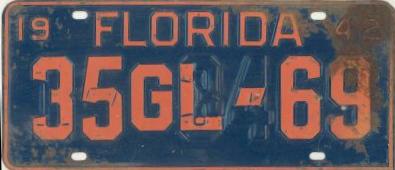
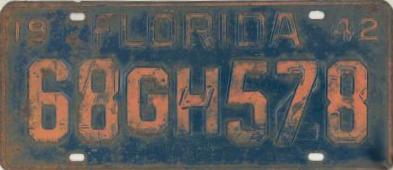
1945
Many, but not all of Maryland's 1945 expiration plates had a digit of the serial # restamped. They had probably already made some 1943 expiration plates in pairs when they decided instead to renew the 1942 expiration plates with metal date tabs. They then restamped one plate out of each 1943 pair to make unique serials and also restamped the year, and issued these plates singly as 1945 expiration plates.
the 1942 plates were issued in pairs. The 1942 plate became the first
Maryland multi-year base plate, as metal tabs dated 1943 and 1944 were
issued to extend the expiration year stamped on the base plate. The 1943
tabs were also issued in pairs, but only a single 1944 tab was issued.
A new base plate was issued for 1945 expirations; it was identical in design
to the 1942 base and differed only in that the colors were reversed to
silver on black; however, only a single plate was issued on the 1945 base
An interesting detail about the 1945 base is that some of them were
stamped a second time to change a digit of the serial number. There does
not appear to be a consistent pattern for this restamping. The 1945 base
pictured above had its first digit changed from a "3" to a "5", as you
can see from the close-up photo. I've seen photos of other 1945 plates
that had been restamped, one where the first digit was changed from a "4"
to a "1", and another where the second digit was changed from a "2" to
a "5" (the first digit was already a "5" in this case). Also, on my example
at least, it looks like the last digit of the year was also restamped to
change the expiration year from 1943 to 1945. (This is impossible to see
in a photo and difficult to see in person, because of the size of the digit.)
I've seen a photo of a 1943 sample plate, but no real 1943 expiration plates
were issued. It would seem that the state had intended to produce 1943
expiration plates and had already manufactured some, when, due to the metal
shortage caused by World War II, they decided to hold on to the 1943 plates
they already had and issue the 1943 renewal tabs instead. Probably the
1943 plates were made in pairs, but the 1945 plates were issued singly,
so apparently one of each pair was restamped to a create a different serial
number.
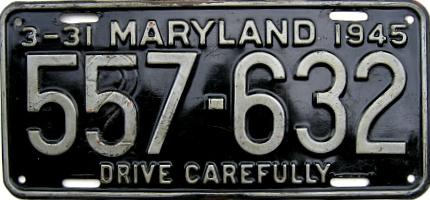
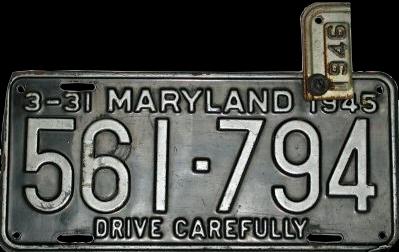
1944
1942 Minnesota Restruck License Plate
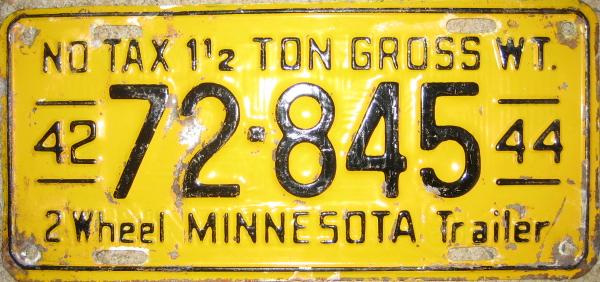
1944
1944 1-Ton Mississippi Overstamped License Plate
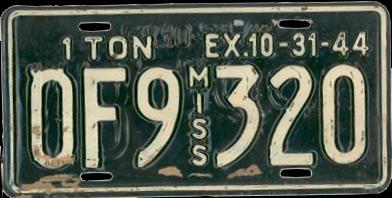
1944 1 1/2-Ton Mississippi Overstamped License Plate
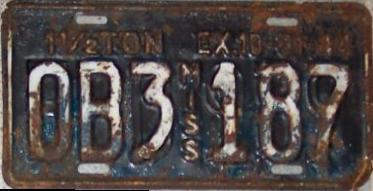
1945
1945 1-Ton Mississippi Overstamped License Plate
1945 1 1/2-Ton Mississippi Overstamped License Plate
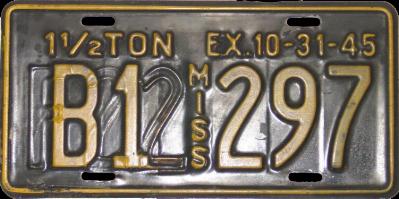
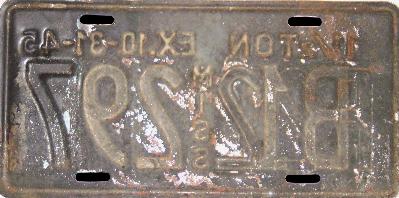
1943
1943 Montana tabs were made from previous year's plates that were restamped
to include the 1943 date
Montana used a fiberboard plate in 1944, and some of them were done
on the other side of an expired plate from another state, IL.
Can anyone please send me better pictures
to post here ?
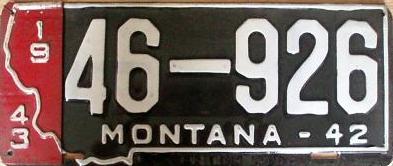
1944
Some 1944 Montana plates were made from 1943 Illinois Fiberboard plates!
Thus creating 2 sided license plates from 2 different states.
Recycling and saving metal for the war effort at it's finest.
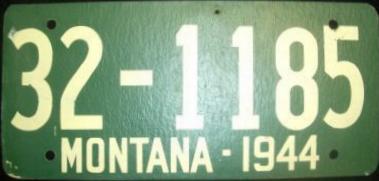
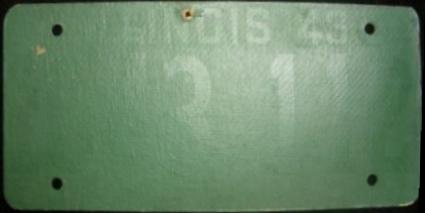
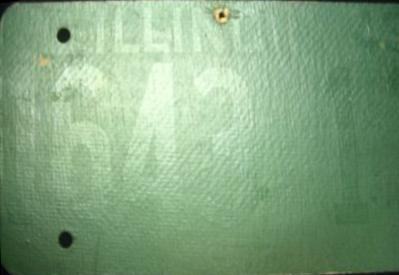
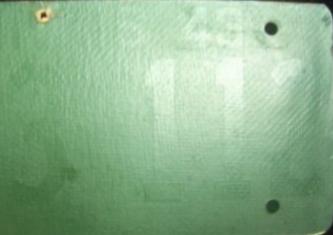
1940
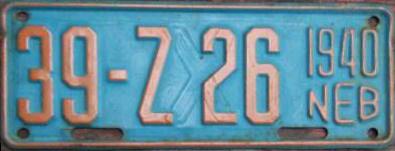
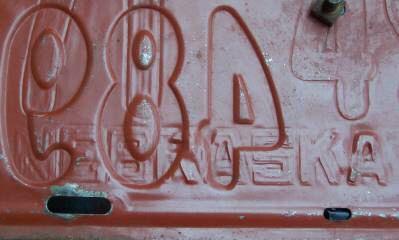
1944
New York stamped 1942 plates in pairs, but issued only one of the plates.
For 1943, the 1942 plates were renewed with a metal strip tab that attached
to both top bolt holes. In 1944, NY finally issued the unused 1942 plate,
restamped as a 1944 with the last digit in the date restamped from a '2'
to a '4'.
The 1942 plates were yellow on black, but the 1944 plates were black
on yellow.

1943
1942 was remanufactured to flat and re-stamped 1943
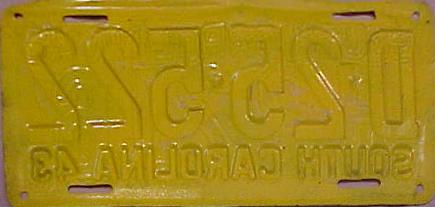
1942
previous years plates were remanufactured to flat and re-stamped 1942
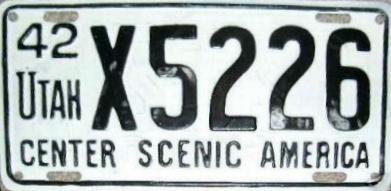
1946
previous years plates were restamped to flat and re-stamped 1942
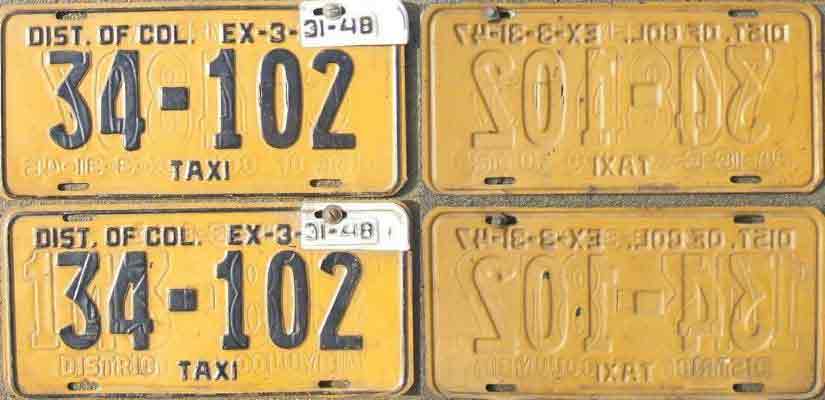
1944
Manitoba 1941 passenger plates were recycled and restamped as 1944 Trailer
plates. The 'TR' was painted on as a prefix to indicate trailer,
but was not embossed.
Can anyone please send me pictures to post
here ?
1943
In 1942, Nova Scotia plates were stamped out as pairs, but only one
plate was issued.
The mate was held back and stamped out as a 1943 plate. This
was done to save metal for the War.
Evidence of the 1942 colors (black on green) are visable on this plate.
1943
1943 Ontario plates made by overstamping the 1942 plates.
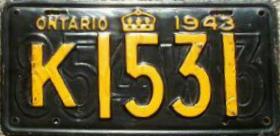
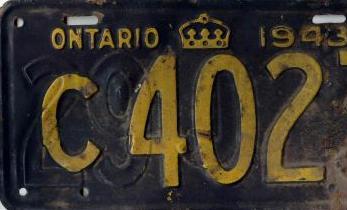
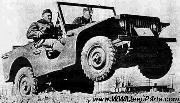
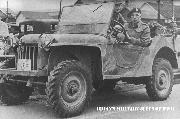
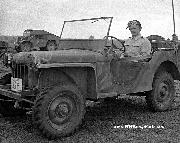
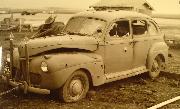
Eary Jeeps (1-3). A 1941 Staff Car at Pearl Harbor on Dec. 7th 1941
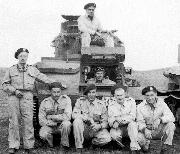
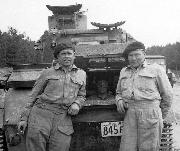
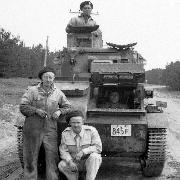
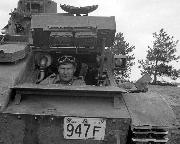
British/Canadian Vickers Mk VI Light Tanks
<<Nice photos of the Ontario F suffix plates on the military vehicles. They look to be the '41 base. I'm pretty sure that was the first year for the F suffix plates, and they were issued in '42 and '43, anually. Then in '45 they came out with permanent white on brown plates, which were used up to 1968. Since then the Dept of Defense has taken over registry of all military vehicles, with plates marked CANADA. More can be found here: http://www.canplates.com/canforces.html
I can supply you with a scan of a DC plate restamped if you wish.
It's a '47 restamped over a '46 I believe.
You'll want to mention that NS did basically the same deal as NY except
for '42 and '43. '42 was black on pale green and '43 was white on
black. The '43 plate was validated in '44 with a windshield sticker.
Nfld did something similar as well. the '44 plate was a repainted
'42, except they didn't restamp the date. The '42 is orange on black,
and the '44 is red on black. Strangely enough they did have a '43
plate in the interim, white on black.
Cheers,
Tiger Joe>>
South Carolina 1942 Paul Thomas ALPCA 4114
garfield731@ftc-i.net
+++++++++++++
1939 - 1946 California License Plates: The WWII Era in California
1942 US, Canada, & World License Plates Display Page
List of 1942 - 1945 US and Canada License Plates Types
Restamped US & Canadian License Plates - The WWII Metal Shortage Years
WWII Military License Plates & Patriotic License Plate Toppers
How to Stuff License Plates into a Flat Rate Priority Envelope
| BACK TO
|
|||||
| Table
of
Contents |
Post
your Free
Classified Ads |
Link
to this
website |
Navigation
Help |
||
![]()
![]()
Please don't pirate my pictures or text. Ask
my permission.
Copyright
© 1998-2012 Brian French. All Rights Reserved
Free counters provided by Andale.
Automobile License Plate Collectors Association (ALPCA) - http://www.alpca.org
Thanks for the help on this License Plates Page goes to the following
people:
'Tiger' Joe Sallman -
David Turner - ALPCA #2467
Barney Williams - Muskogee, OK - ALPCA #2635 - website
Dave Steckley - Acton Ontario - ALPCA #1296
Mike - ALPCA #3989
Paul Thomas - ALPCA #4114
John Shoesmith - ALPCA #8226
Rick Kretschmer - Raleigh, NC - ALPCA #9652 - website
- MD Photos & text Used with permission.
Ned Flynn - ALPCA #2083
Peter Cohen - Pleasanton, CA
Les Gottleib -
Kenneth Rendell - Museum of WWII - Boston, MA website
John Connors - TROOPER TAGS website
The DC '48 taxi pair is interesting, since each plate seems to have been stamped from a different crushed plate. The top plate seems to have come from a 1946 commercial plate, C-4807 backwards. The bottom plate seems to be from a passenger plate 43-812 - date is hard to read, 1946 I assume?
I have never seen anything like this.
You're welcome to use both these photos on your website with credit given to me ('Tiger' Joe Sallmen).